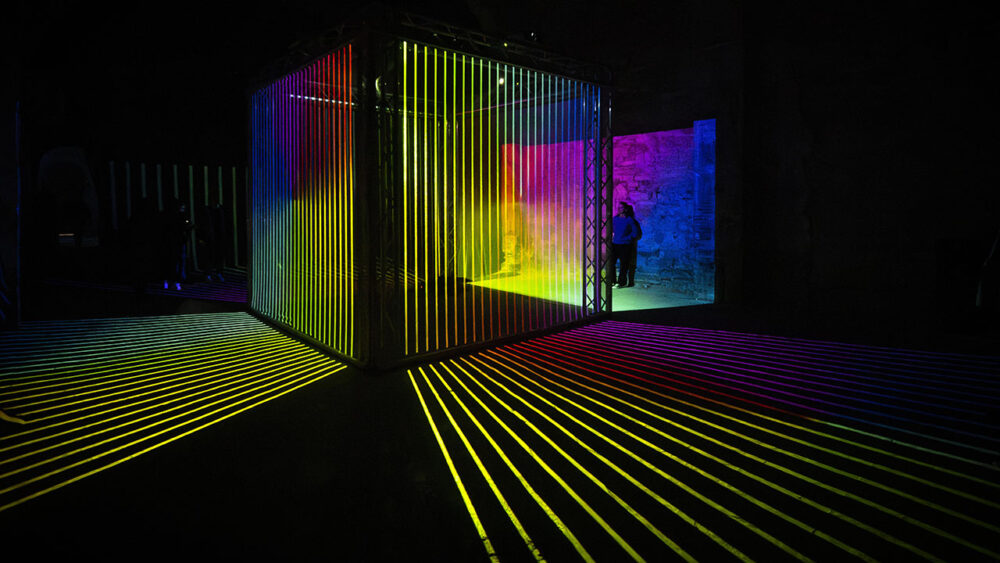Mad Arts means business in 2024. The organization—which is an incubator for technology-forward projects and collaborations—announced in December the opening of an immersive new art museum. The opening of this permanent home in Dania Beach marks a watershed moment for South Florida’s art and technology ecosystem.
With more than triple the current gallery space and an outdoor garden, the multi-million-dollar museum expansion enables Mad Arts to present an elevated high-tech program showcasing experiential artwork driven by emerging technologies.
Executive Director Marc Aptakin’s vision for the 50,000-square-foot building is a bold concept that responds to the rapid pace of technological advancements and the importance of culture as a unifying force.
“Our vision for the Mad Arts Museum is a response to the rapid pace of technological advancements that highlight the importance of culture as a unifying force,” Aptakin says. “This new expansion will allow us to broaden the diverse spectrum of immersive art installations and provide much needed educational programs to further support our community’s cultural capital and diverse interests. When art is presented in its truest form by artists who want to advance change, it opens the door for guests to think, grow, and learn in an environment that is as unique as the people who visit.”
The museum’s opening will have more than 20 exhibitions from a diverse range of artists. The highlights of the inaugural program at Mad Arts are RÉSONANCES, an installation by Canadian artist LP Rondeau co-produced by ELEKTRA and distributed by Wireframe Public Art; Core (2020), by the French company Adrien M & Claire B; SysCalls, by Stockholm-based artist Jaime Reyes and re|thread, a collective of software researchers, artists and designers; and The Light Pours Out of Me, an intermedia performance/sound installation by local artist Richard Vergez.

Key to the entire experience is an educational flair. “Shortly after the museum opens, MadLabs Academy will be in full swing, teaching both students and professional artists how to infuse technology into their artwork,” Aptakin says. “Because the museum is backed by our Innovation Agency, MadLabs, students have the opportunity to interact with all of the technology that we use every day. From engineering to fabrication, there are a million things involved, and all those elements will be taught within the academy. Students can learn about 3D scanning or projection mapping, gaining access to our incredible motion capture studio. They will have the much-needed hands-on access to the technology they need to grow their knowledge base as both artists and technologists.”
On the new second floor, Mad Arts will showcase the commissioned work of renowned Japanese artist Makoto Tojiki titled Existence, which is inspired by the interconnectedness of light and shadow; three holographic projections sculptures by Studio McGuire: Ophelia, The Hunter, and Sirens; LASER LIKE WATER, an immersive laser, sound, and water installation by JS Baillat, Ottomata, and Diagraf; an immersive installation by OLO creative farm titled 4TH DIMENSION; the acclaimed installation by Akiko Yamashita, Forest Perception—if a tree talks in a forest, does anyone listen?
Thomas Garnier brings both Taotie, a technological reinterpretation of Fantasmagoria shadow play from the eighteenth century, and Strates, an installation based on photomontage work that superimposes two eras; a site-specific commission that will become part of Mad Arts’ permanent collection called The Empty Mirror of the Sky, by the artist collective Shuster + Moseley, where visitors can contemplate the flickering strands and spontaneous spheres of light reflected on a series of suspended lenses; and the work by Mad Arts’ engine collaborator MadLabs, with three site-specific installations: Luminescent Sylva, Infinite Dimensions and Nano Groove, in addition to hidden gems that visitors will discover while on site.
These commissions show Mad Arts’ commitment to experimentation, risk and believing in artists’ projects by taking them from ideation to completion. And, according to Aptakin, it’s only the beginning. “Moving forward,” he says, “MadLabs Academy also hopes to pair students with high-level artists to work on installations that will later be shown in the museum. There is a constant parade of artists interacting with our technology and we are teaching them new ways to express themselves, from learning TouchDesigner to understanding how to use Dragon O hardware from LED Pulse.”
Whenever tech and education are involved, Mad Arts will be one to watch in 2024 and well beyond.














